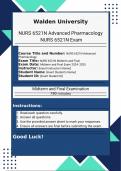Walden University
Chamberlain University
NUR 546
NURS 6521NPsychopharmacology for the
Advanced Pharmacology
Psychiatric- Mental Health Nurse
NURS 6521N ExamPractitioner
NUR 546 Final
Course TitleTitle
Course and Number: NUR 546 Psychopharmacology
and Number: for the
NURS 6521N Advanced
Psychiatric-Mental
Pharmacology Health Nurse Practitioner
Exam Title: NURS 6521N Midterm and Final
Exam Title: NUR 546 Final
Exam Date: Midterm and Final Exam 2024- 2025
Instructor: [Insert
Exam Date: Final ExamInstructor’s
2024- 2025Name]
Student Name: [Insert Student’s Name]
Student
Instructor:ID:
[Insert Instructor’s
[Insert Student Name]
ID]
Student Name: [Insert Student’s Name]
Midterm
Student ID: andID]Final
[Insert Student Examination
180 minutes
Final Examination
Instructions: 180 minutes
1. Read each question carefully.
Instructions:
2. Answer all questions.
1. Read each question carefully.
3.2.Use the provided
Answer answer sheet to mark your responses.
all questions.
4.3.Ensure
Use theall answers
provided are final
answer sheetbefore
to marksubmitting the exam.
your responses.
4. Ensure all answers are final before submitting the exam.
Good
Good Luck!Luck!
,NURS 6521N Advanced Pharmacology 2024 – 2025
NURS 6521N Final Exam Quiz Study Guide | Questions
and Answers | 100% Pass | Graded A+ |
antipsychotic medications - Answer>> Prescription drugs
that are used to reduce psychotic symptoms; frequently used in
the treatment of schizophrenia; also called neuroleptics.
Block dopamine, acetylcholine, histamine, and norepinephrine
receptors in the brain and periphery. Acute and chronic
psychosis, schizophrenia, manic phase of bipolar disorders,
Tourette's syndrome, delusional and schizoaffective disorders,
dementia. Conventional (typical) or atypical.
Patient education: s/s of orthostatic hypotension - move slowly
when standing up. Sedation - avoid hazardous activities such
as driving until sedation wears off.
Impaires libido and erection / ejaculation
*avoid anticholinergic drugs, barbiturates, benzos and alcohol.
first generation antipsychotics - Answer>> a group of
medications originally developed to combat psychotic
symptoms by reducing dopamine levels in the brain; also called
conventional or typical antipsychotics
block receptors for dopamine, acetylcholine, histamine, and
norepinephrine
Ex.
(low potency): Chlorpromazine, Thioridazine
s/e orthostatic hyposension, long Q-T syndrome, high sedation
(medium potency): loxapine, perhenazine,
s/e moderate sedation
(high potency):fluphenazine, haloperidol, pimozide, thiothoxene,
frifluoperizine
s/e movement problems
,Albuterol - Answer>> Class: Short acting B2 agonist with
minor B1
Used for: Bronchospasms associated with asthma, bronchitis
(acute or chronic), and COPD
ADR: Potential drug-induced hyperglycemia, cardiac
arrhythmias, some CNS excitation effects (tremors, dizziness),
HA, tachycardia, palpitations
Comments: Safe for children and pregnancy; may combine with
ipratropium; least expensive
Terbutaline - Answer>> Class: Short acting B2 agonist with
minor B1
Used for: Bronchospasms associated with asthma, bronchitis
(acute or chronic), and COPD
ADR: Potential drug-induced hyperglycemia, cardiac
arrhythmias, some CNS excitation effects (tremors, dizziness),
HA, tachycardia, palpitations
X: Pregnancy category B or C
Salmeterol - Answer>> Class: Long acting B2 agonist, more
selective
Used for: Bronchospasms associated with asthma, bronchitis
(acute or chronic), and COPD
ADR: Potential drug-induced hyperglycemia, cardiac
arrhythmias, some CNS excitation effects (tremors, dizziness),
HA, tachycardia, palpitations
Comments: Do not use alone for persistent asthma, combine
with an inhaled corticosteroid; don't wash it, powder can get
clogged
What are some things you can educate your patients on
regarding beta agonist inhalers? - Answer>> 1. Demonstrate
and have patient do return demonstration
2. Check correct inhaler use if patient says it's not working
3. Encourage use of spacer
, Fluticasone - Answer>> Class: Inhaled corticosteroid
Used for: 1st line treatment for persistent asthma
MOA: Anti-inflammatory, minimal systemic exposure
Budesonide - Answer>> Class: Inhaled corticosteroid
Used for: 1st line treatment for persistent asthma
MOA: Anti-inflammatory, minimal systemic exposure
Zafirlukast - Answer>> Class: Leukotriene
modifier/antagonist
Used for: 2nd line to decrease bronchoconstriction, edema
MOA: Works similar to prostaglandins in r/t to inflammation,
blocks lipoxygenase
Theophylline - Answer>> Class: Xanthine; stimulant
Used for: Asthma
MOA: Bronchial smooth muscle relaxation
ADR: cardiovascular effects, increased gastric acid production,
CNS effects (irritability, restlessness, seizures, insomnia), GI
effects (reflux, worsens heartburn), cardiac effects
(palpitations, tachycardia, hypotension, life-threatening
arrhythmias)
X: GERD, HTN, ischemic heart dx, coronary insufficiency, CHF,
history of stroke, cardiac arrhythmias; smoking increases
clearance
Comments: Stay away from charcoal-broiled foods
(accelerates the hepatic metabolism), avoid large amounts of
caffeine containing beverages; elimination is influenced by diet
What are the signs of Theophylline toxicity? - Answer>>
Vomiting, insomnia, jitteriness, HA, severe GI pain, irregular
heartbeat
Ipratropium Bromide - Answer>> Class: Inhaled
anticholinergic
Used for: NOT 1st line, supplemental use in acute
bronchospasm




